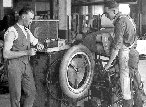![[Industrial Trail Logo]](logosmall.jpg) MADE
IN HAMILTON
MADE
IN HAMILTON20TH CENTURY
INDUSTRIAL TRAIL
![[Industrial Trail Logo]](logosmall.jpg) MADE
IN HAMILTON
MADE
IN HAMILTON
20TH CENTURY
INDUSTRIAL TRAIL
SITE
16
FIRESTONE
TIRE & RUBBER COMPANY
OF CANADA, 1923
 After
you cross Kenilworth Avenue, try to catch a glimpse of the original Firestone
building pictured here. It is nestled among a number of shorter buildings and
set well back from the north side of Burlington Street.
After
you cross Kenilworth Avenue, try to catch a glimpse of the original Firestone
building pictured here. It is nestled among a number of shorter buildings and
set well back from the north side of Burlington Street.
 In
1919, the Firestone Tire & Rubber Company of Akron, Ohio chose Hamilton as the
site of its first plant outside the U.S. The company bought 124 acres fronting
on Hamilton Harbour and constructed "one of the strongest...buildings in Canada."
The first tire rolled off the line in 1922. Initially, over 150 workers built
tires here.
In
1919, the Firestone Tire & Rubber Company of Akron, Ohio chose Hamilton as the
site of its first plant outside the U.S. The company bought 124 acres fronting
on Hamilton Harbour and constructed "one of the strongest...buildings in Canada."
The first tire rolled off the line in 1922. Initially, over 150 workers built
tires here.
After the Second World War, the Hamilton plant doubled its productive capacity. It expanded to Calgary, Alberta and Joliette, Quebec. The company and the federal government tried to boost sagging profits by investing heavily in the plant in the 1970s and early 1980s. But this was not enough. The plant was closed in early 1988.
Hamilton Firestone workers formed one of the city's most active industrial unions. Local 113 of the United Rubberworkers of America was one of the main forces in the strike wave that gripped Hamilton in 1946. Many striking rubberworkers were war veterans who, after fighting overseas, were determined to win the battle for industrial democracy at home.
Firestone hired the prominent Hamilton architectural firm of Hutton and Souter to design the original plant. Their design used a reinforced concrete grid structure exposed on the exterior with curtain walls of brick and large multi-paned windows, making the plant strong, spacious and bright by the standards of the day.
Workers at this plant were organized as United Rubberworkers of America Local 133.